Business Strategy Analysis of Vodafone: Impact of Macro and Micro Environment, Internal Capabilities, and Competitive Forces
VerifiedAdded on 2023/06/13
|17
|5461
|239
AI Summary
This report analyzes the business strategy of Vodafone, a British-owned telecommunication company operating in more than 22 countries globally. It critically evaluates the impact of macro and micro environment, internal capabilities, and competitive forces on the company's growth inducing strategies. The report also provides insights on how to improve competitive edge and market position based on the outcomes of the analysis.
Contribute Materials
Your contribution can guide someone’s learning journey. Share your
documents today.
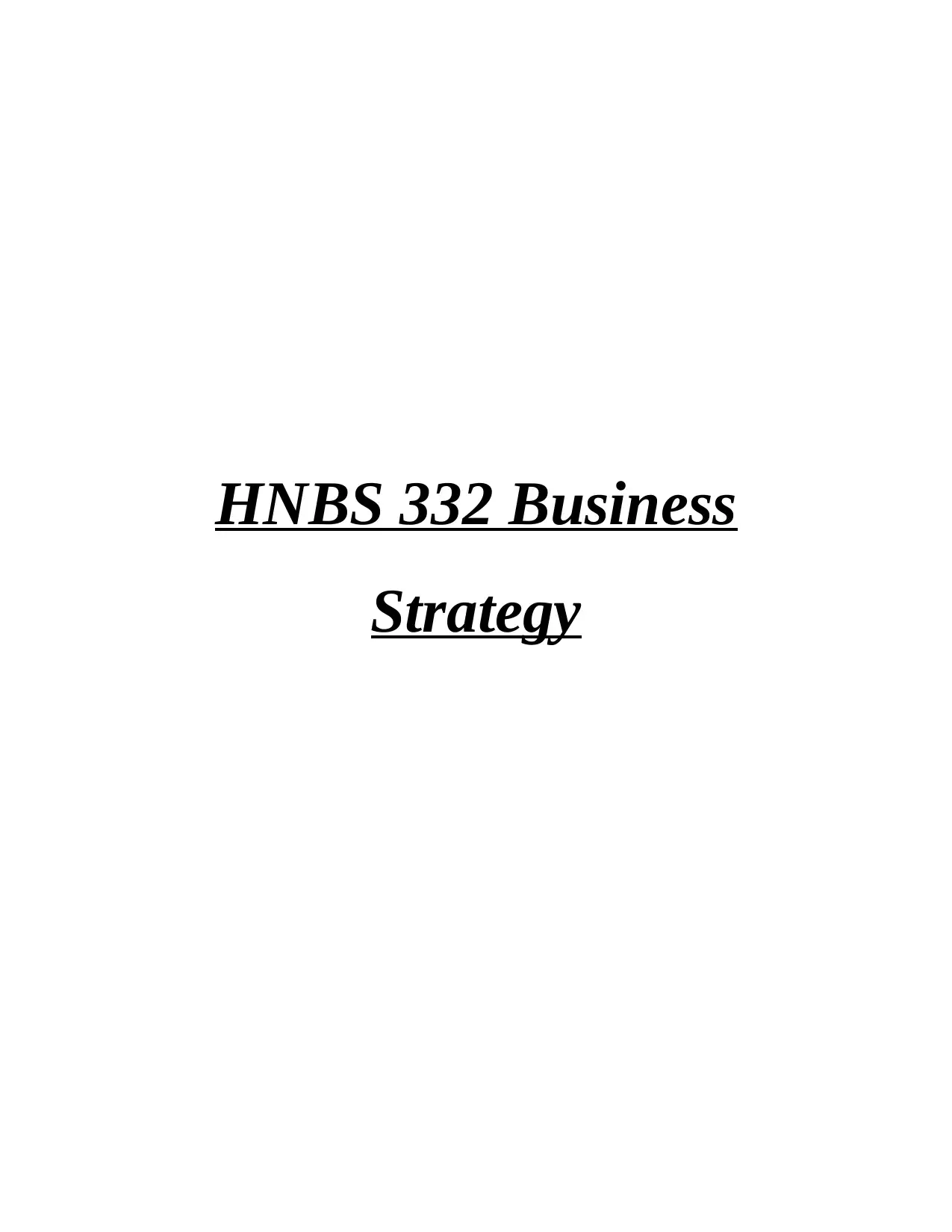
HNBS 332 Business
Strategy
Strategy
Secure Best Marks with AI Grader
Need help grading? Try our AI Grader for instant feedback on your assignments.
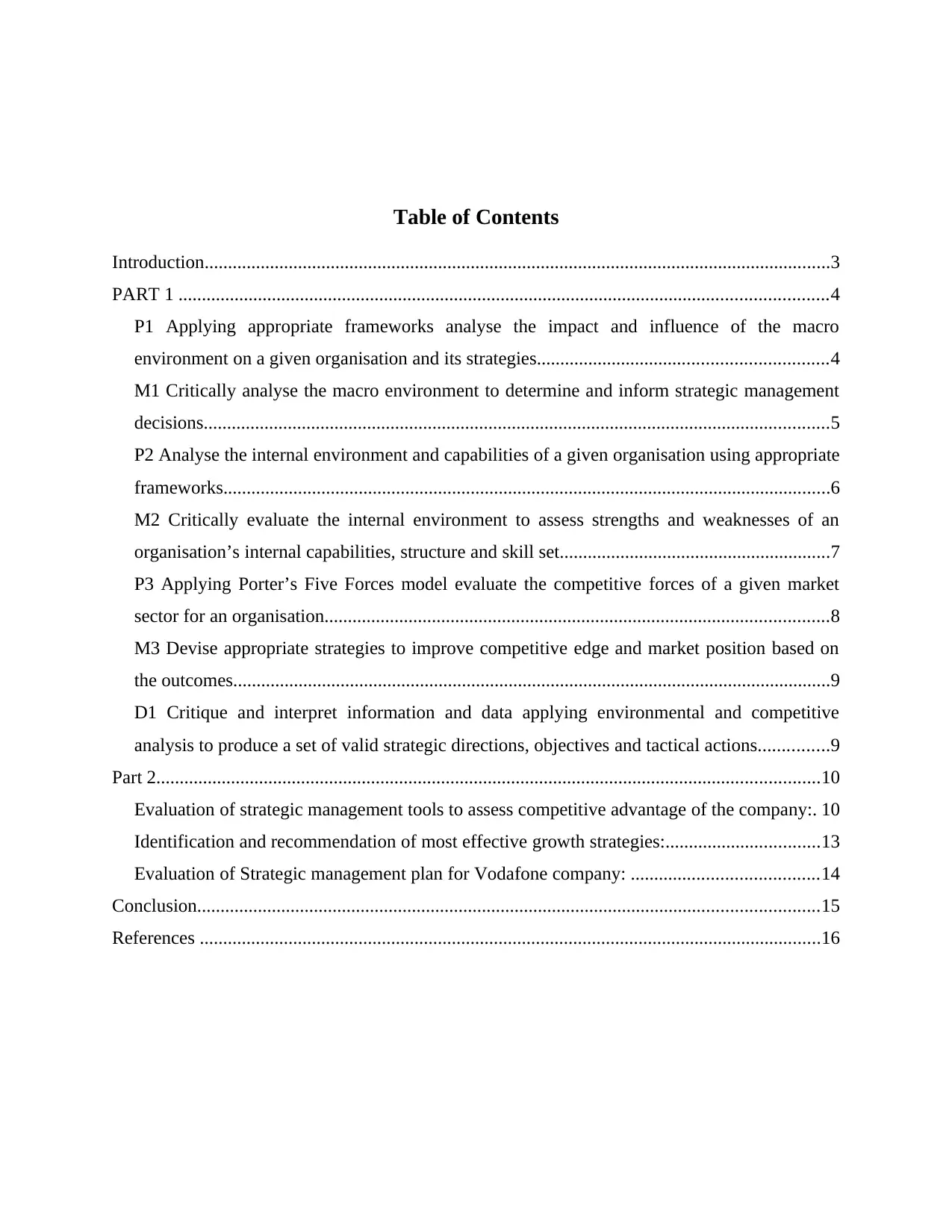
Table of Contents
Introduction......................................................................................................................................3
PART 1 ...........................................................................................................................................4
P1 Applying appropriate frameworks analyse the impact and influence of the macro
environment on a given organisation and its strategies..............................................................4
M1 Critically analyse the macro environment to determine and inform strategic management
decisions......................................................................................................................................5
P2 Analyse the internal environment and capabilities of a given organisation using appropriate
frameworks..................................................................................................................................6
M2 Critically evaluate the internal environment to assess strengths and weaknesses of an
organisation’s internal capabilities, structure and skill set..........................................................7
P3 Applying Porter’s Five Forces model evaluate the competitive forces of a given market
sector for an organisation............................................................................................................8
M3 Devise appropriate strategies to improve competitive edge and market position based on
the outcomes................................................................................................................................9
D1 Critique and interpret information and data applying environmental and competitive
analysis to produce a set of valid strategic directions, objectives and tactical actions...............9
Part 2..............................................................................................................................................10
Evaluation of strategic management tools to assess competitive advantage of the company:. 10
Identification and recommendation of most effective growth strategies:.................................13
Evaluation of Strategic management plan for Vodafone company: ........................................14
Conclusion.....................................................................................................................................15
References .....................................................................................................................................16
Introduction......................................................................................................................................3
PART 1 ...........................................................................................................................................4
P1 Applying appropriate frameworks analyse the impact and influence of the macro
environment on a given organisation and its strategies..............................................................4
M1 Critically analyse the macro environment to determine and inform strategic management
decisions......................................................................................................................................5
P2 Analyse the internal environment and capabilities of a given organisation using appropriate
frameworks..................................................................................................................................6
M2 Critically evaluate the internal environment to assess strengths and weaknesses of an
organisation’s internal capabilities, structure and skill set..........................................................7
P3 Applying Porter’s Five Forces model evaluate the competitive forces of a given market
sector for an organisation............................................................................................................8
M3 Devise appropriate strategies to improve competitive edge and market position based on
the outcomes................................................................................................................................9
D1 Critique and interpret information and data applying environmental and competitive
analysis to produce a set of valid strategic directions, objectives and tactical actions...............9
Part 2..............................................................................................................................................10
Evaluation of strategic management tools to assess competitive advantage of the company:. 10
Identification and recommendation of most effective growth strategies:.................................13
Evaluation of Strategic management plan for Vodafone company: ........................................14
Conclusion.....................................................................................................................................15
References .....................................................................................................................................16
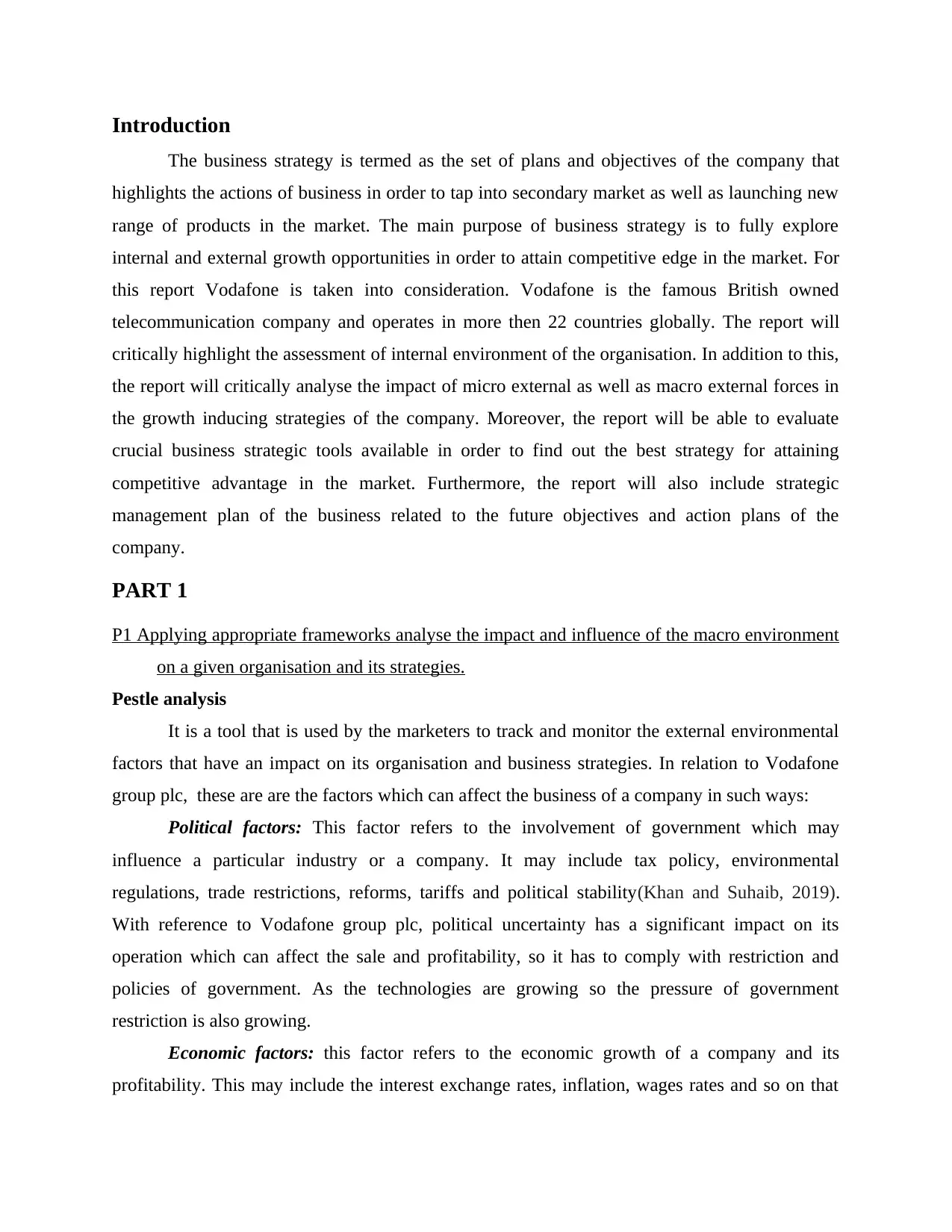
Introduction
The business strategy is termed as the set of plans and objectives of the company that
highlights the actions of business in order to tap into secondary market as well as launching new
range of products in the market. The main purpose of business strategy is to fully explore
internal and external growth opportunities in order to attain competitive edge in the market. For
this report Vodafone is taken into consideration. Vodafone is the famous British owned
telecommunication company and operates in more then 22 countries globally. The report will
critically highlight the assessment of internal environment of the organisation. In addition to this,
the report will critically analyse the impact of micro external as well as macro external forces in
the growth inducing strategies of the company. Moreover, the report will be able to evaluate
crucial business strategic tools available in order to find out the best strategy for attaining
competitive advantage in the market. Furthermore, the report will also include strategic
management plan of the business related to the future objectives and action plans of the
company.
PART 1
P1 Applying appropriate frameworks analyse the impact and influence of the macro environment
on a given organisation and its strategies.
Pestle analysis
It is a tool that is used by the marketers to track and monitor the external environmental
factors that have an impact on its organisation and business strategies. In relation to Vodafone
group plc, these are are the factors which can affect the business of a company in such ways:
Political factors: This factor refers to the involvement of government which may
influence a particular industry or a company. It may include tax policy, environmental
regulations, trade restrictions, reforms, tariffs and political stability(Khan and Suhaib, 2019).
With reference to Vodafone group plc, political uncertainty has a significant impact on its
operation which can affect the sale and profitability, so it has to comply with restriction and
policies of government. As the technologies are growing so the pressure of government
restriction is also growing.
Economic factors: this factor refers to the economic growth of a company and its
profitability. This may include the interest exchange rates, inflation, wages rates and so on that
The business strategy is termed as the set of plans and objectives of the company that
highlights the actions of business in order to tap into secondary market as well as launching new
range of products in the market. The main purpose of business strategy is to fully explore
internal and external growth opportunities in order to attain competitive edge in the market. For
this report Vodafone is taken into consideration. Vodafone is the famous British owned
telecommunication company and operates in more then 22 countries globally. The report will
critically highlight the assessment of internal environment of the organisation. In addition to this,
the report will critically analyse the impact of micro external as well as macro external forces in
the growth inducing strategies of the company. Moreover, the report will be able to evaluate
crucial business strategic tools available in order to find out the best strategy for attaining
competitive advantage in the market. Furthermore, the report will also include strategic
management plan of the business related to the future objectives and action plans of the
company.
PART 1
P1 Applying appropriate frameworks analyse the impact and influence of the macro environment
on a given organisation and its strategies.
Pestle analysis
It is a tool that is used by the marketers to track and monitor the external environmental
factors that have an impact on its organisation and business strategies. In relation to Vodafone
group plc, these are are the factors which can affect the business of a company in such ways:
Political factors: This factor refers to the involvement of government which may
influence a particular industry or a company. It may include tax policy, environmental
regulations, trade restrictions, reforms, tariffs and political stability(Khan and Suhaib, 2019).
With reference to Vodafone group plc, political uncertainty has a significant impact on its
operation which can affect the sale and profitability, so it has to comply with restriction and
policies of government. As the technologies are growing so the pressure of government
restriction is also growing.
Economic factors: this factor refers to the economic growth of a company and its
profitability. This may include the interest exchange rates, inflation, wages rates and so on that
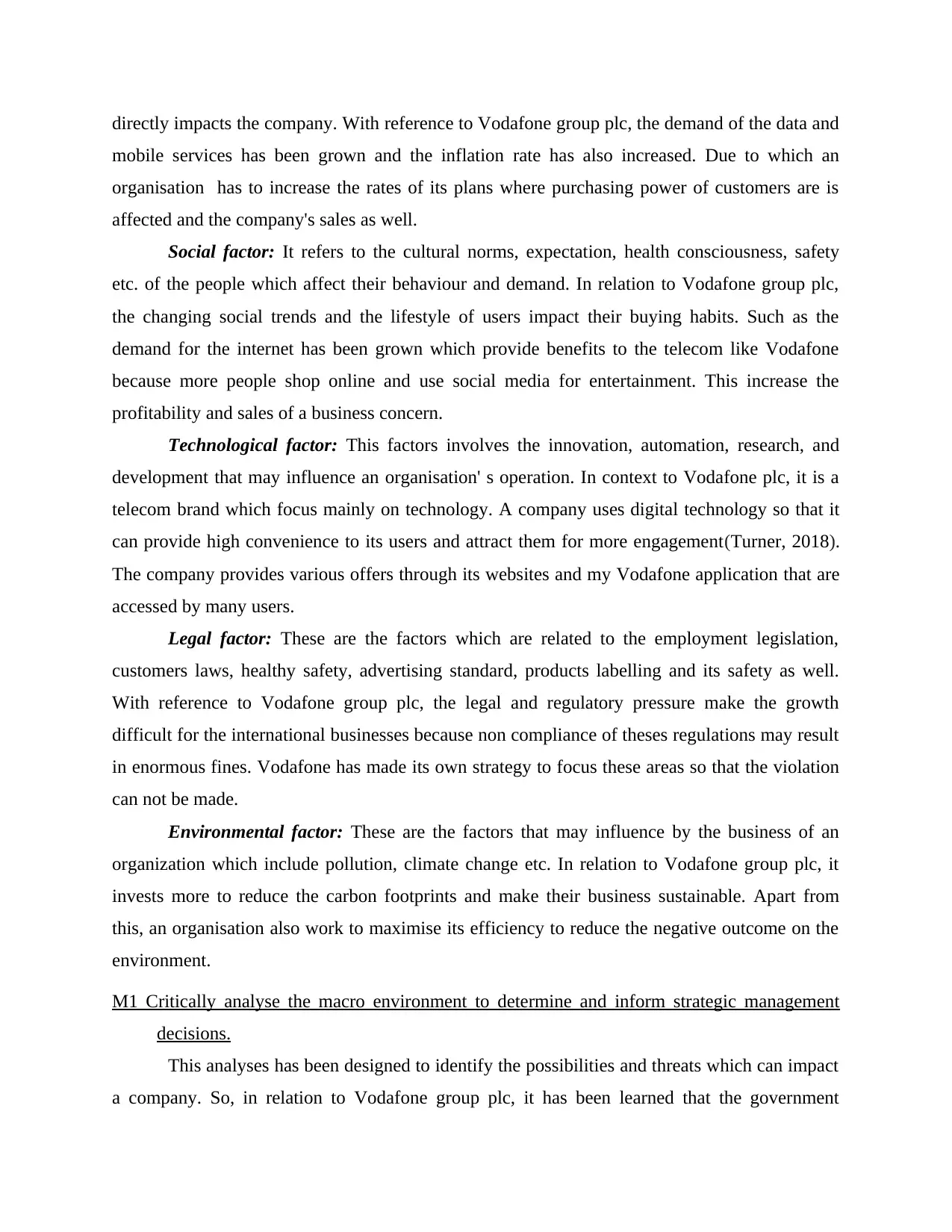
directly impacts the company. With reference to Vodafone group plc, the demand of the data and
mobile services has been grown and the inflation rate has also increased. Due to which an
organisation has to increase the rates of its plans where purchasing power of customers are is
affected and the company's sales as well.
Social factor: It refers to the cultural norms, expectation, health consciousness, safety
etc. of the people which affect their behaviour and demand. In relation to Vodafone group plc,
the changing social trends and the lifestyle of users impact their buying habits. Such as the
demand for the internet has been grown which provide benefits to the telecom like Vodafone
because more people shop online and use social media for entertainment. This increase the
profitability and sales of a business concern.
Technological factor: This factors involves the innovation, automation, research, and
development that may influence an organisation' s operation. In context to Vodafone plc, it is a
telecom brand which focus mainly on technology. A company uses digital technology so that it
can provide high convenience to its users and attract them for more engagement(Turner, 2018).
The company provides various offers through its websites and my Vodafone application that are
accessed by many users.
Legal factor: These are the factors which are related to the employment legislation,
customers laws, healthy safety, advertising standard, products labelling and its safety as well.
With reference to Vodafone group plc, the legal and regulatory pressure make the growth
difficult for the international businesses because non compliance of theses regulations may result
in enormous fines. Vodafone has made its own strategy to focus these areas so that the violation
can not be made.
Environmental factor: These are the factors that may influence by the business of an
organization which include pollution, climate change etc. In relation to Vodafone group plc, it
invests more to reduce the carbon footprints and make their business sustainable. Apart from
this, an organisation also work to maximise its efficiency to reduce the negative outcome on the
environment.
M1 Critically analyse the macro environment to determine and inform strategic management
decisions.
This analyses has been designed to identify the possibilities and threats which can impact
a company. So, in relation to Vodafone group plc, it has been learned that the government
mobile services has been grown and the inflation rate has also increased. Due to which an
organisation has to increase the rates of its plans where purchasing power of customers are is
affected and the company's sales as well.
Social factor: It refers to the cultural norms, expectation, health consciousness, safety
etc. of the people which affect their behaviour and demand. In relation to Vodafone group plc,
the changing social trends and the lifestyle of users impact their buying habits. Such as the
demand for the internet has been grown which provide benefits to the telecom like Vodafone
because more people shop online and use social media for entertainment. This increase the
profitability and sales of a business concern.
Technological factor: This factors involves the innovation, automation, research, and
development that may influence an organisation' s operation. In context to Vodafone plc, it is a
telecom brand which focus mainly on technology. A company uses digital technology so that it
can provide high convenience to its users and attract them for more engagement(Turner, 2018).
The company provides various offers through its websites and my Vodafone application that are
accessed by many users.
Legal factor: These are the factors which are related to the employment legislation,
customers laws, healthy safety, advertising standard, products labelling and its safety as well.
With reference to Vodafone group plc, the legal and regulatory pressure make the growth
difficult for the international businesses because non compliance of theses regulations may result
in enormous fines. Vodafone has made its own strategy to focus these areas so that the violation
can not be made.
Environmental factor: These are the factors that may influence by the business of an
organization which include pollution, climate change etc. In relation to Vodafone group plc, it
invests more to reduce the carbon footprints and make their business sustainable. Apart from
this, an organisation also work to maximise its efficiency to reduce the negative outcome on the
environment.
M1 Critically analyse the macro environment to determine and inform strategic management
decisions.
This analyses has been designed to identify the possibilities and threats which can impact
a company. So, in relation to Vodafone group plc, it has been learned that the government
Paraphrase This Document
Need a fresh take? Get an instant paraphrase of this document with our AI Paraphraser
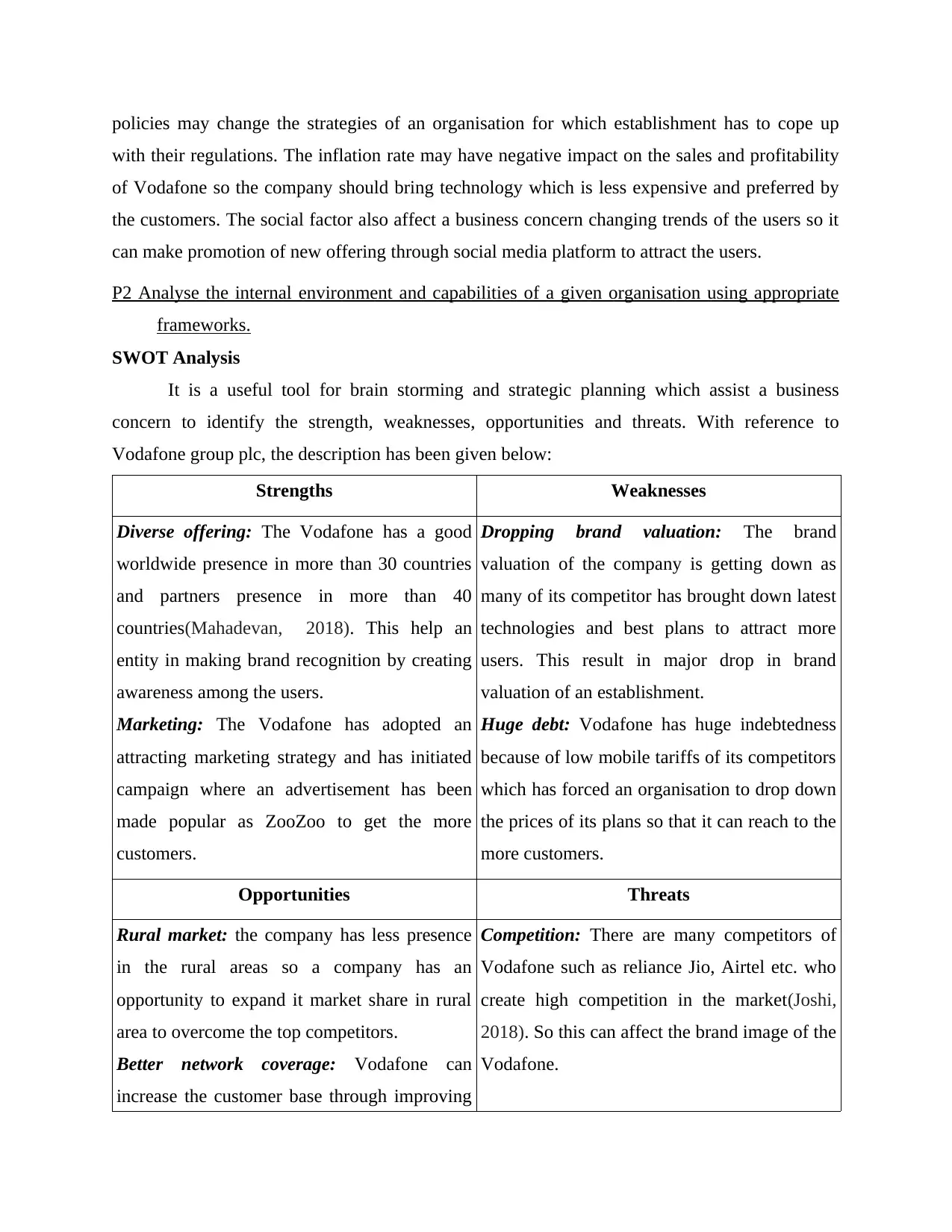
policies may change the strategies of an organisation for which establishment has to cope up
with their regulations. The inflation rate may have negative impact on the sales and profitability
of Vodafone so the company should bring technology which is less expensive and preferred by
the customers. The social factor also affect a business concern changing trends of the users so it
can make promotion of new offering through social media platform to attract the users.
P2 Analyse the internal environment and capabilities of a given organisation using appropriate
frameworks.
SWOT Analysis
It is a useful tool for brain storming and strategic planning which assist a business
concern to identify the strength, weaknesses, opportunities and threats. With reference to
Vodafone group plc, the description has been given below:
Strengths Weaknesses
Diverse offering: The Vodafone has a good
worldwide presence in more than 30 countries
and partners presence in more than 40
countries(Mahadevan, 2018). This help an
entity in making brand recognition by creating
awareness among the users.
Marketing: The Vodafone has adopted an
attracting marketing strategy and has initiated
campaign where an advertisement has been
made popular as ZooZoo to get the more
customers.
Dropping brand valuation: The brand
valuation of the company is getting down as
many of its competitor has brought down latest
technologies and best plans to attract more
users. This result in major drop in brand
valuation of an establishment.
Huge debt: Vodafone has huge indebtedness
because of low mobile tariffs of its competitors
which has forced an organisation to drop down
the prices of its plans so that it can reach to the
more customers.
Opportunities Threats
Rural market: the company has less presence
in the rural areas so a company has an
opportunity to expand it market share in rural
area to overcome the top competitors.
Better network coverage: Vodafone can
increase the customer base through improving
Competition: There are many competitors of
Vodafone such as reliance Jio, Airtel etc. who
create high competition in the market(Joshi,
2018). So this can affect the brand image of the
Vodafone.
with their regulations. The inflation rate may have negative impact on the sales and profitability
of Vodafone so the company should bring technology which is less expensive and preferred by
the customers. The social factor also affect a business concern changing trends of the users so it
can make promotion of new offering through social media platform to attract the users.
P2 Analyse the internal environment and capabilities of a given organisation using appropriate
frameworks.
SWOT Analysis
It is a useful tool for brain storming and strategic planning which assist a business
concern to identify the strength, weaknesses, opportunities and threats. With reference to
Vodafone group plc, the description has been given below:
Strengths Weaknesses
Diverse offering: The Vodafone has a good
worldwide presence in more than 30 countries
and partners presence in more than 40
countries(Mahadevan, 2018). This help an
entity in making brand recognition by creating
awareness among the users.
Marketing: The Vodafone has adopted an
attracting marketing strategy and has initiated
campaign where an advertisement has been
made popular as ZooZoo to get the more
customers.
Dropping brand valuation: The brand
valuation of the company is getting down as
many of its competitor has brought down latest
technologies and best plans to attract more
users. This result in major drop in brand
valuation of an establishment.
Huge debt: Vodafone has huge indebtedness
because of low mobile tariffs of its competitors
which has forced an organisation to drop down
the prices of its plans so that it can reach to the
more customers.
Opportunities Threats
Rural market: the company has less presence
in the rural areas so a company has an
opportunity to expand it market share in rural
area to overcome the top competitors.
Better network coverage: Vodafone can
increase the customer base through improving
Competition: There are many competitors of
Vodafone such as reliance Jio, Airtel etc. who
create high competition in the market(Joshi,
2018). So this can affect the brand image of the
Vodafone.
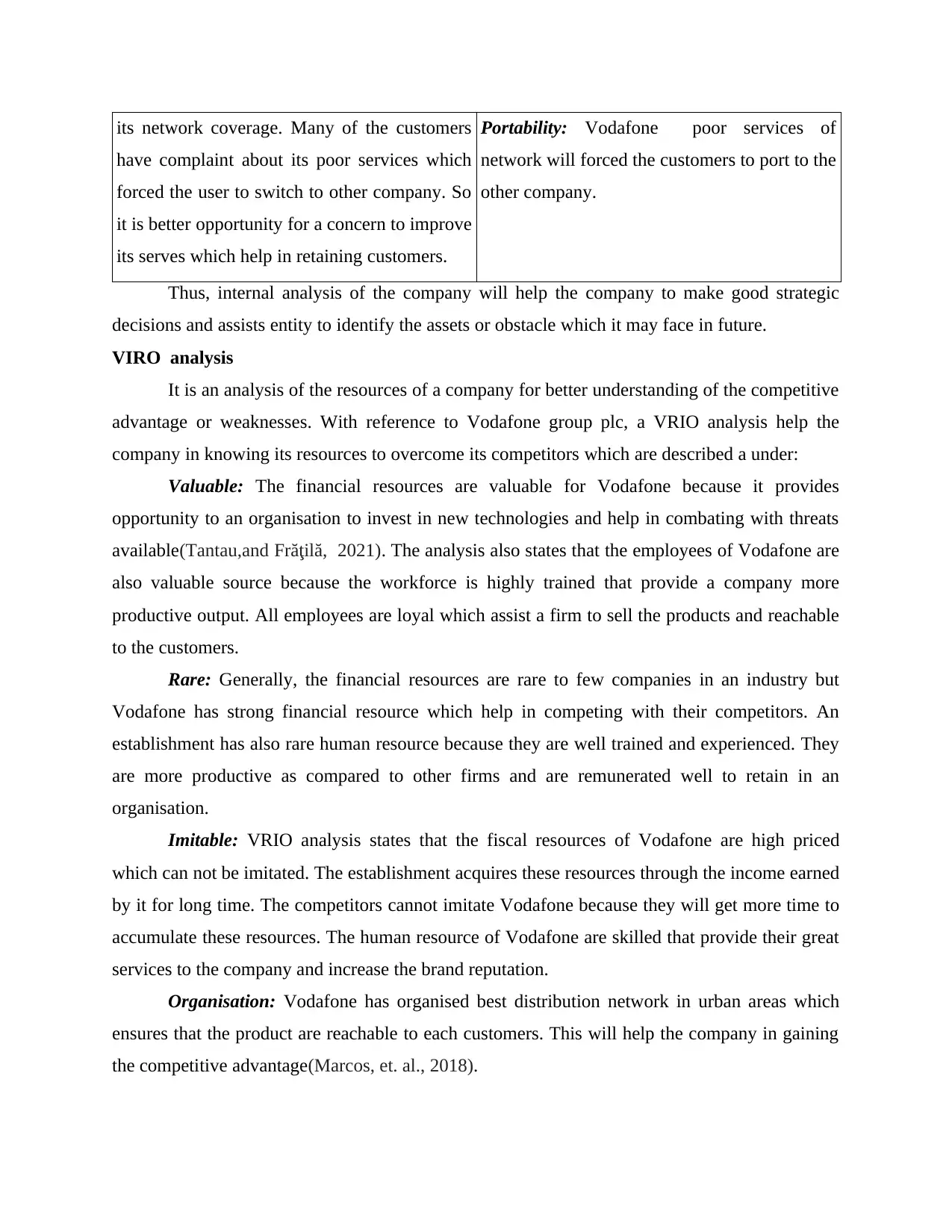
its network coverage. Many of the customers
have complaint about its poor services which
forced the user to switch to other company. So
it is better opportunity for a concern to improve
its serves which help in retaining customers.
Portability: Vodafone poor services of
network will forced the customers to port to the
other company.
Thus, internal analysis of the company will help the company to make good strategic
decisions and assists entity to identify the assets or obstacle which it may face in future.
VIRO analysis
It is an analysis of the resources of a company for better understanding of the competitive
advantage or weaknesses. With reference to Vodafone group plc, a VRIO analysis help the
company in knowing its resources to overcome its competitors which are described a under:
Valuable: The financial resources are valuable for Vodafone because it provides
opportunity to an organisation to invest in new technologies and help in combating with threats
available(Tantau,and Frăţilă, 2021). The analysis also states that the employees of Vodafone are
also valuable source because the workforce is highly trained that provide a company more
productive output. All employees are loyal which assist a firm to sell the products and reachable
to the customers.
Rare: Generally, the financial resources are rare to few companies in an industry but
Vodafone has strong financial resource which help in competing with their competitors. An
establishment has also rare human resource because they are well trained and experienced. They
are more productive as compared to other firms and are remunerated well to retain in an
organisation.
Imitable: VRIO analysis states that the fiscal resources of Vodafone are high priced
which can not be imitated. The establishment acquires these resources through the income earned
by it for long time. The competitors cannot imitate Vodafone because they will get more time to
accumulate these resources. The human resource of Vodafone are skilled that provide their great
services to the company and increase the brand reputation.
Organisation: Vodafone has organised best distribution network in urban areas which
ensures that the product are reachable to each customers. This will help the company in gaining
the competitive advantage(Marcos, et. al., 2018).
have complaint about its poor services which
forced the user to switch to other company. So
it is better opportunity for a concern to improve
its serves which help in retaining customers.
Portability: Vodafone poor services of
network will forced the customers to port to the
other company.
Thus, internal analysis of the company will help the company to make good strategic
decisions and assists entity to identify the assets or obstacle which it may face in future.
VIRO analysis
It is an analysis of the resources of a company for better understanding of the competitive
advantage or weaknesses. With reference to Vodafone group plc, a VRIO analysis help the
company in knowing its resources to overcome its competitors which are described a under:
Valuable: The financial resources are valuable for Vodafone because it provides
opportunity to an organisation to invest in new technologies and help in combating with threats
available(Tantau,and Frăţilă, 2021). The analysis also states that the employees of Vodafone are
also valuable source because the workforce is highly trained that provide a company more
productive output. All employees are loyal which assist a firm to sell the products and reachable
to the customers.
Rare: Generally, the financial resources are rare to few companies in an industry but
Vodafone has strong financial resource which help in competing with their competitors. An
establishment has also rare human resource because they are well trained and experienced. They
are more productive as compared to other firms and are remunerated well to retain in an
organisation.
Imitable: VRIO analysis states that the fiscal resources of Vodafone are high priced
which can not be imitated. The establishment acquires these resources through the income earned
by it for long time. The competitors cannot imitate Vodafone because they will get more time to
accumulate these resources. The human resource of Vodafone are skilled that provide their great
services to the company and increase the brand reputation.
Organisation: Vodafone has organised best distribution network in urban areas which
ensures that the product are reachable to each customers. This will help the company in gaining
the competitive advantage(Marcos, et. al., 2018).
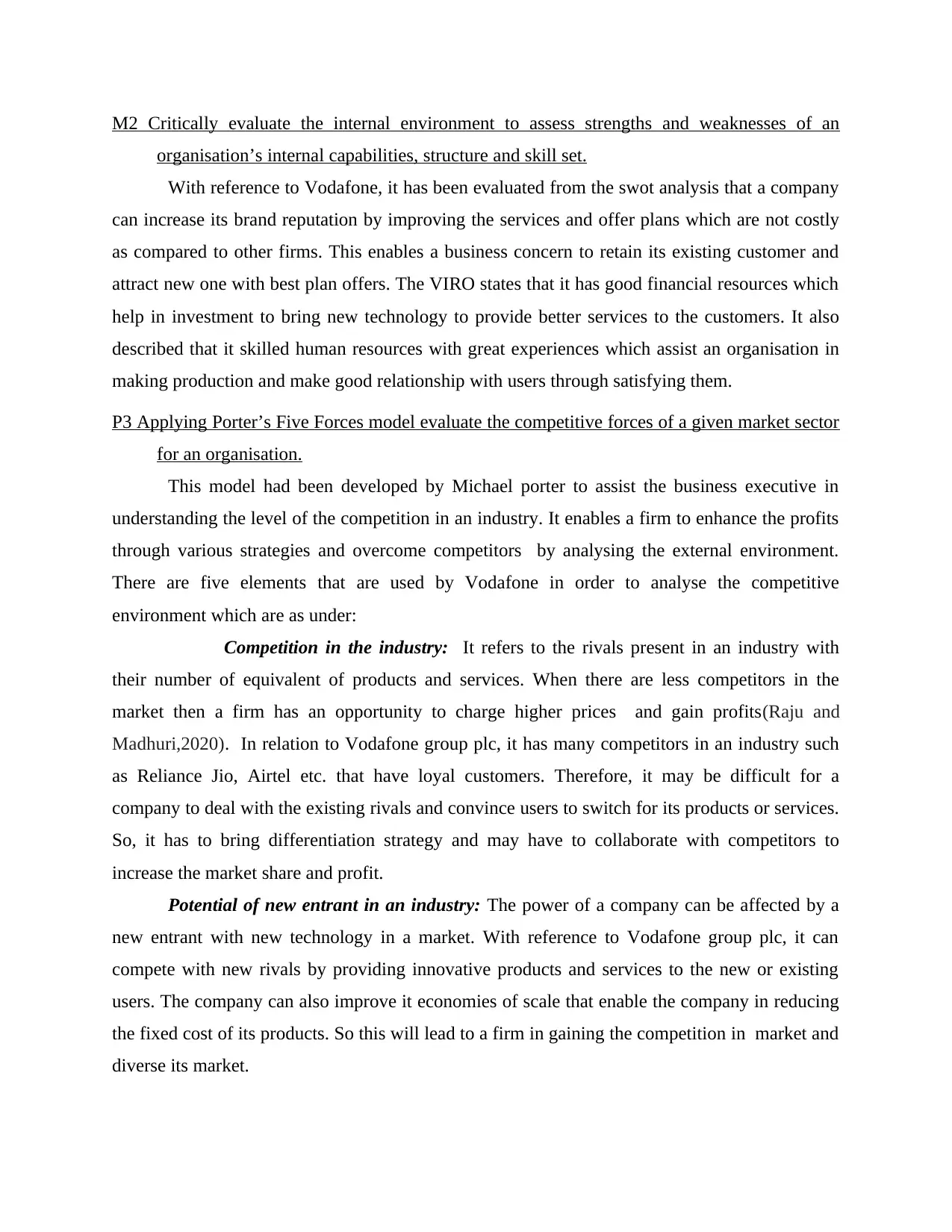
M2 Critically evaluate the internal environment to assess strengths and weaknesses of an
organisation’s internal capabilities, structure and skill set.
With reference to Vodafone, it has been evaluated from the swot analysis that a company
can increase its brand reputation by improving the services and offer plans which are not costly
as compared to other firms. This enables a business concern to retain its existing customer and
attract new one with best plan offers. The VIRO states that it has good financial resources which
help in investment to bring new technology to provide better services to the customers. It also
described that it skilled human resources with great experiences which assist an organisation in
making production and make good relationship with users through satisfying them.
P3 Applying Porter’s Five Forces model evaluate the competitive forces of a given market sector
for an organisation.
This model had been developed by Michael porter to assist the business executive in
understanding the level of the competition in an industry. It enables a firm to enhance the profits
through various strategies and overcome competitors by analysing the external environment.
There are five elements that are used by Vodafone in order to analyse the competitive
environment which are as under:
Competition in the industry: It refers to the rivals present in an industry with
their number of equivalent of products and services. When there are less competitors in the
market then a firm has an opportunity to charge higher prices and gain profits(Raju and
Madhuri,2020). In relation to Vodafone group plc, it has many competitors in an industry such
as Reliance Jio, Airtel etc. that have loyal customers. Therefore, it may be difficult for a
company to deal with the existing rivals and convince users to switch for its products or services.
So, it has to bring differentiation strategy and may have to collaborate with competitors to
increase the market share and profit.
Potential of new entrant in an industry: The power of a company can be affected by a
new entrant with new technology in a market. With reference to Vodafone group plc, it can
compete with new rivals by providing innovative products and services to the new or existing
users. The company can also improve it economies of scale that enable the company in reducing
the fixed cost of its products. So this will lead to a firm in gaining the competition in market and
diverse its market.
organisation’s internal capabilities, structure and skill set.
With reference to Vodafone, it has been evaluated from the swot analysis that a company
can increase its brand reputation by improving the services and offer plans which are not costly
as compared to other firms. This enables a business concern to retain its existing customer and
attract new one with best plan offers. The VIRO states that it has good financial resources which
help in investment to bring new technology to provide better services to the customers. It also
described that it skilled human resources with great experiences which assist an organisation in
making production and make good relationship with users through satisfying them.
P3 Applying Porter’s Five Forces model evaluate the competitive forces of a given market sector
for an organisation.
This model had been developed by Michael porter to assist the business executive in
understanding the level of the competition in an industry. It enables a firm to enhance the profits
through various strategies and overcome competitors by analysing the external environment.
There are five elements that are used by Vodafone in order to analyse the competitive
environment which are as under:
Competition in the industry: It refers to the rivals present in an industry with
their number of equivalent of products and services. When there are less competitors in the
market then a firm has an opportunity to charge higher prices and gain profits(Raju and
Madhuri,2020). In relation to Vodafone group plc, it has many competitors in an industry such
as Reliance Jio, Airtel etc. that have loyal customers. Therefore, it may be difficult for a
company to deal with the existing rivals and convince users to switch for its products or services.
So, it has to bring differentiation strategy and may have to collaborate with competitors to
increase the market share and profit.
Potential of new entrant in an industry: The power of a company can be affected by a
new entrant with new technology in a market. With reference to Vodafone group plc, it can
compete with new rivals by providing innovative products and services to the new or existing
users. The company can also improve it economies of scale that enable the company in reducing
the fixed cost of its products. So this will lead to a firm in gaining the competition in market and
diverse its market.
Secure Best Marks with AI Grader
Need help grading? Try our AI Grader for instant feedback on your assignments.
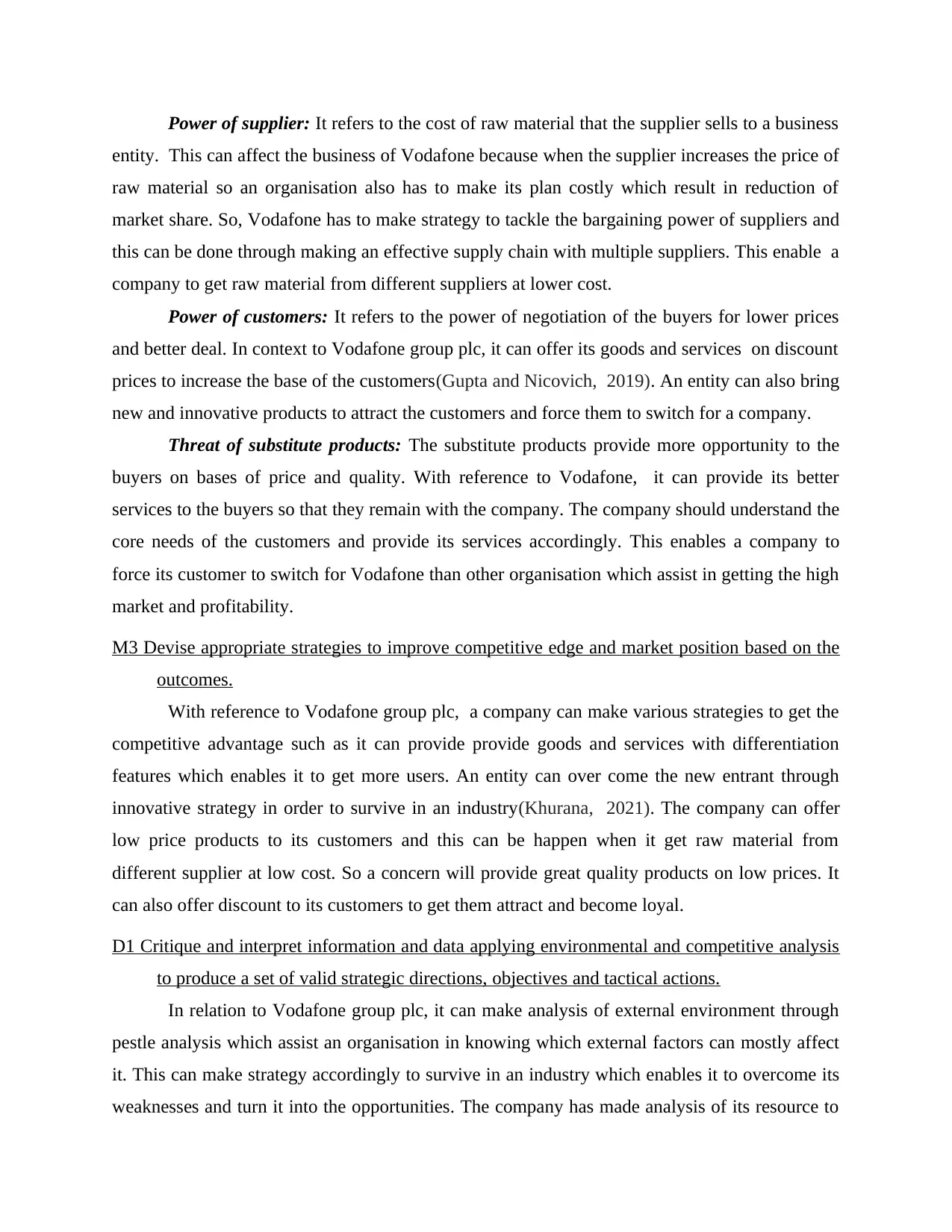
Power of supplier: It refers to the cost of raw material that the supplier sells to a business
entity. This can affect the business of Vodafone because when the supplier increases the price of
raw material so an organisation also has to make its plan costly which result in reduction of
market share. So, Vodafone has to make strategy to tackle the bargaining power of suppliers and
this can be done through making an effective supply chain with multiple suppliers. This enable a
company to get raw material from different suppliers at lower cost.
Power of customers: It refers to the power of negotiation of the buyers for lower prices
and better deal. In context to Vodafone group plc, it can offer its goods and services on discount
prices to increase the base of the customers(Gupta and Nicovich, 2019). An entity can also bring
new and innovative products to attract the customers and force them to switch for a company.
Threat of substitute products: The substitute products provide more opportunity to the
buyers on bases of price and quality. With reference to Vodafone, it can provide its better
services to the buyers so that they remain with the company. The company should understand the
core needs of the customers and provide its services accordingly. This enables a company to
force its customer to switch for Vodafone than other organisation which assist in getting the high
market and profitability.
M3 Devise appropriate strategies to improve competitive edge and market position based on the
outcomes.
With reference to Vodafone group plc, a company can make various strategies to get the
competitive advantage such as it can provide provide goods and services with differentiation
features which enables it to get more users. An entity can over come the new entrant through
innovative strategy in order to survive in an industry(Khurana, 2021). The company can offer
low price products to its customers and this can be happen when it get raw material from
different supplier at low cost. So a concern will provide great quality products on low prices. It
can also offer discount to its customers to get them attract and become loyal.
D1 Critique and interpret information and data applying environmental and competitive analysis
to produce a set of valid strategic directions, objectives and tactical actions.
In relation to Vodafone group plc, it can make analysis of external environment through
pestle analysis which assist an organisation in knowing which external factors can mostly affect
it. This can make strategy accordingly to survive in an industry which enables it to overcome its
weaknesses and turn it into the opportunities. The company has made analysis of its resource to
entity. This can affect the business of Vodafone because when the supplier increases the price of
raw material so an organisation also has to make its plan costly which result in reduction of
market share. So, Vodafone has to make strategy to tackle the bargaining power of suppliers and
this can be done through making an effective supply chain with multiple suppliers. This enable a
company to get raw material from different suppliers at lower cost.
Power of customers: It refers to the power of negotiation of the buyers for lower prices
and better deal. In context to Vodafone group plc, it can offer its goods and services on discount
prices to increase the base of the customers(Gupta and Nicovich, 2019). An entity can also bring
new and innovative products to attract the customers and force them to switch for a company.
Threat of substitute products: The substitute products provide more opportunity to the
buyers on bases of price and quality. With reference to Vodafone, it can provide its better
services to the buyers so that they remain with the company. The company should understand the
core needs of the customers and provide its services accordingly. This enables a company to
force its customer to switch for Vodafone than other organisation which assist in getting the high
market and profitability.
M3 Devise appropriate strategies to improve competitive edge and market position based on the
outcomes.
With reference to Vodafone group plc, a company can make various strategies to get the
competitive advantage such as it can provide provide goods and services with differentiation
features which enables it to get more users. An entity can over come the new entrant through
innovative strategy in order to survive in an industry(Khurana, 2021). The company can offer
low price products to its customers and this can be happen when it get raw material from
different supplier at low cost. So a concern will provide great quality products on low prices. It
can also offer discount to its customers to get them attract and become loyal.
D1 Critique and interpret information and data applying environmental and competitive analysis
to produce a set of valid strategic directions, objectives and tactical actions.
In relation to Vodafone group plc, it can make analysis of external environment through
pestle analysis which assist an organisation in knowing which external factors can mostly affect
it. This can make strategy accordingly to survive in an industry which enables it to overcome its
weaknesses and turn it into the opportunities. The company has made analysis of its resource to
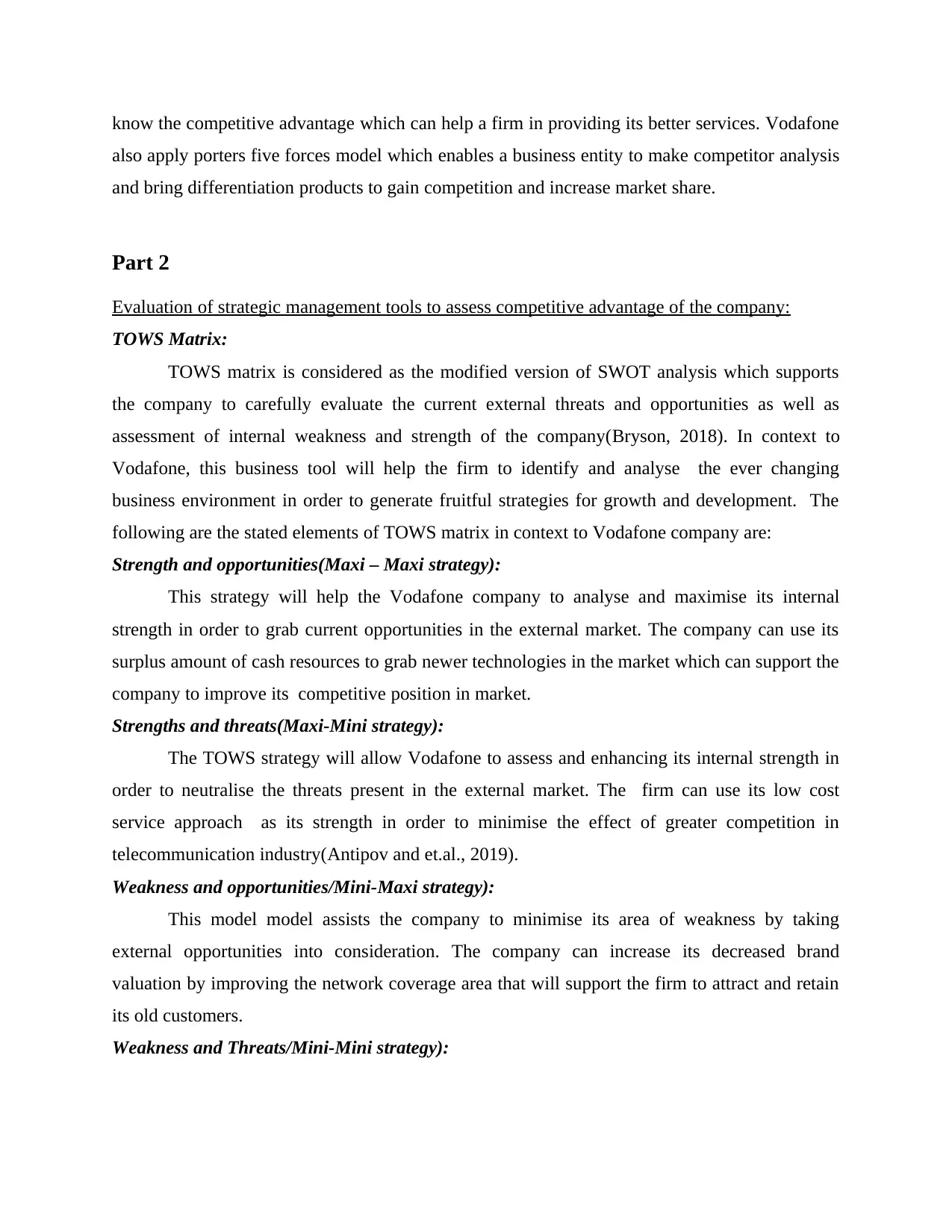
know the competitive advantage which can help a firm in providing its better services. Vodafone
also apply porters five forces model which enables a business entity to make competitor analysis
and bring differentiation products to gain competition and increase market share.
Part 2
Evaluation of strategic management tools to assess competitive advantage of the company:
TOWS Matrix:
TOWS matrix is considered as the modified version of SWOT analysis which supports
the company to carefully evaluate the current external threats and opportunities as well as
assessment of internal weakness and strength of the company(Bryson, 2018). In context to
Vodafone, this business tool will help the firm to identify and analyse the ever changing
business environment in order to generate fruitful strategies for growth and development. The
following are the stated elements of TOWS matrix in context to Vodafone company are:
Strength and opportunities(Maxi – Maxi strategy):
This strategy will help the Vodafone company to analyse and maximise its internal
strength in order to grab current opportunities in the external market. The company can use its
surplus amount of cash resources to grab newer technologies in the market which can support the
company to improve its competitive position in market.
Strengths and threats(Maxi-Mini strategy):
The TOWS strategy will allow Vodafone to assess and enhancing its internal strength in
order to neutralise the threats present in the external market. The firm can use its low cost
service approach as its strength in order to minimise the effect of greater competition in
telecommunication industry(Antipov and et.al., 2019).
Weakness and opportunities/Mini-Maxi strategy):
This model model assists the company to minimise its area of weakness by taking
external opportunities into consideration. The company can increase its decreased brand
valuation by improving the network coverage area that will support the firm to attract and retain
its old customers.
Weakness and Threats/Mini-Mini strategy):
also apply porters five forces model which enables a business entity to make competitor analysis
and bring differentiation products to gain competition and increase market share.
Part 2
Evaluation of strategic management tools to assess competitive advantage of the company:
TOWS Matrix:
TOWS matrix is considered as the modified version of SWOT analysis which supports
the company to carefully evaluate the current external threats and opportunities as well as
assessment of internal weakness and strength of the company(Bryson, 2018). In context to
Vodafone, this business tool will help the firm to identify and analyse the ever changing
business environment in order to generate fruitful strategies for growth and development. The
following are the stated elements of TOWS matrix in context to Vodafone company are:
Strength and opportunities(Maxi – Maxi strategy):
This strategy will help the Vodafone company to analyse and maximise its internal
strength in order to grab current opportunities in the external market. The company can use its
surplus amount of cash resources to grab newer technologies in the market which can support the
company to improve its competitive position in market.
Strengths and threats(Maxi-Mini strategy):
The TOWS strategy will allow Vodafone to assess and enhancing its internal strength in
order to neutralise the threats present in the external market. The firm can use its low cost
service approach as its strength in order to minimise the effect of greater competition in
telecommunication industry(Antipov and et.al., 2019).
Weakness and opportunities/Mini-Maxi strategy):
This model model assists the company to minimise its area of weakness by taking
external opportunities into consideration. The company can increase its decreased brand
valuation by improving the network coverage area that will support the firm to attract and retain
its old customers.
Weakness and Threats/Mini-Mini strategy):

The last element of this model supports the firm to decrease its chances of threats by
minimising its weaknesses. The company needs to strength its core values in order to minimise
the effect of high competition and can improve the brand valuation of Vodafone company.
Bowman's Strategy Clock:
In context to Vodafone, this business model supports the company to assess its
competitive position in the market as compared to their competitors. This strategy helps the firm
to know the position of its services in the industry. The following are the elements that will
support Vodafone company to find ways of adding competitive value are:
Low price and low added value:
In this market position, the company keeps their cost of services low as compared to their
competitors but also provide cheap quality of services in the market. This is not considered as
effective strategic position as the company is unable to provide a value to its customers.
Low price:
This type of Bowman's strategy can support the firm to enhance its value in the market by
providing quality services in the cost effective manner. In relation to it, this strategy can allow
the organisation to generate high volume of outputs that can lead the firm to enhance its
generation of profits(Kerzner, 2019).
Hybrid:
The other strategy is considered as effective when the company provides value to their
customers both in aspect of quality services as well as low price. The hybrid model can enable
the firm to attain higher market share by attracting new customers.
Differentiation:
In this strategic position, the firm offers qualitative services to its loyal as well as medium
and high class customers at an average rate. This approach is not considered suitable as the firm
can not attract low class customers in its service value.
Focused differentiation:
In this strategic position, the firm only focus on providing high quality services with
higher prices in order to cater demands of higher class customers in the market. This strategy
allows the firm to practise marketing and promotional activities in order to attain higher amounts
of profits(Ebrahimi and Banaeifard, 2018).
Risky high margins:
minimising its weaknesses. The company needs to strength its core values in order to minimise
the effect of high competition and can improve the brand valuation of Vodafone company.
Bowman's Strategy Clock:
In context to Vodafone, this business model supports the company to assess its
competitive position in the market as compared to their competitors. This strategy helps the firm
to know the position of its services in the industry. The following are the elements that will
support Vodafone company to find ways of adding competitive value are:
Low price and low added value:
In this market position, the company keeps their cost of services low as compared to their
competitors but also provide cheap quality of services in the market. This is not considered as
effective strategic position as the company is unable to provide a value to its customers.
Low price:
This type of Bowman's strategy can support the firm to enhance its value in the market by
providing quality services in the cost effective manner. In relation to it, this strategy can allow
the organisation to generate high volume of outputs that can lead the firm to enhance its
generation of profits(Kerzner, 2019).
Hybrid:
The other strategy is considered as effective when the company provides value to their
customers both in aspect of quality services as well as low price. The hybrid model can enable
the firm to attain higher market share by attracting new customers.
Differentiation:
In this strategic position, the firm offers qualitative services to its loyal as well as medium
and high class customers at an average rate. This approach is not considered suitable as the firm
can not attract low class customers in its service value.
Focused differentiation:
In this strategic position, the firm only focus on providing high quality services with
higher prices in order to cater demands of higher class customers in the market. This strategy
allows the firm to practise marketing and promotional activities in order to attain higher amounts
of profits(Ebrahimi and Banaeifard, 2018).
Risky high margins:
Paraphrase This Document
Need a fresh take? Get an instant paraphrase of this document with our AI Paraphraser
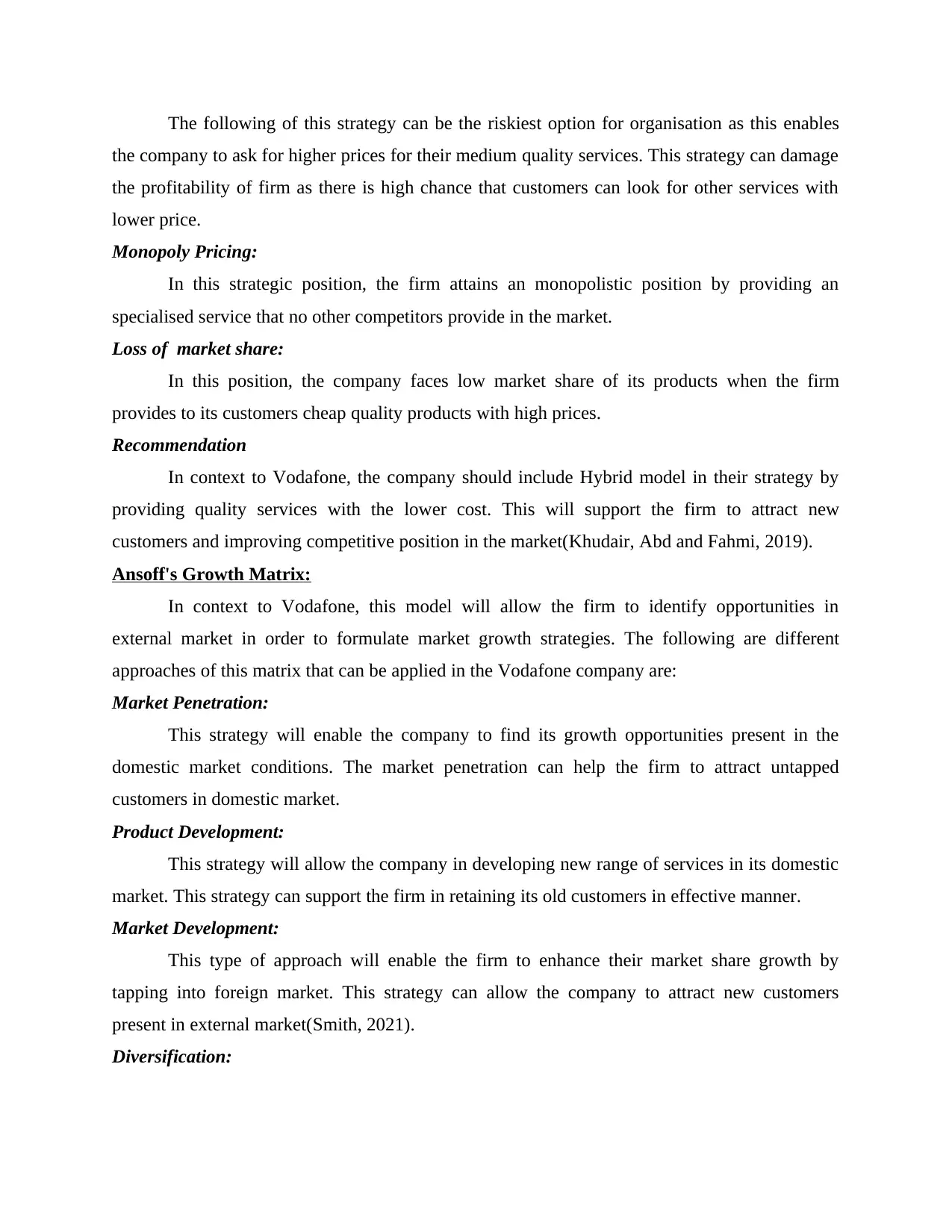
The following of this strategy can be the riskiest option for organisation as this enables
the company to ask for higher prices for their medium quality services. This strategy can damage
the profitability of firm as there is high chance that customers can look for other services with
lower price.
Monopoly Pricing:
In this strategic position, the firm attains an monopolistic position by providing an
specialised service that no other competitors provide in the market.
Loss of market share:
In this position, the company faces low market share of its products when the firm
provides to its customers cheap quality products with high prices.
Recommendation
In context to Vodafone, the company should include Hybrid model in their strategy by
providing quality services with the lower cost. This will support the firm to attract new
customers and improving competitive position in the market(Khudair, Abd and Fahmi, 2019).
Ansoff's Growth Matrix:
In context to Vodafone, this model will allow the firm to identify opportunities in
external market in order to formulate market growth strategies. The following are different
approaches of this matrix that can be applied in the Vodafone company are:
Market Penetration:
This strategy will enable the company to find its growth opportunities present in the
domestic market conditions. The market penetration can help the firm to attract untapped
customers in domestic market.
Product Development:
This strategy will allow the company in developing new range of services in its domestic
market. This strategy can support the firm in retaining its old customers in effective manner.
Market Development:
This type of approach will enable the firm to enhance their market share growth by
tapping into foreign market. This strategy can allow the company to attract new customers
present in external market(Smith, 2021).
Diversification:
the company to ask for higher prices for their medium quality services. This strategy can damage
the profitability of firm as there is high chance that customers can look for other services with
lower price.
Monopoly Pricing:
In this strategic position, the firm attains an monopolistic position by providing an
specialised service that no other competitors provide in the market.
Loss of market share:
In this position, the company faces low market share of its products when the firm
provides to its customers cheap quality products with high prices.
Recommendation
In context to Vodafone, the company should include Hybrid model in their strategy by
providing quality services with the lower cost. This will support the firm to attract new
customers and improving competitive position in the market(Khudair, Abd and Fahmi, 2019).
Ansoff's Growth Matrix:
In context to Vodafone, this model will allow the firm to identify opportunities in
external market in order to formulate market growth strategies. The following are different
approaches of this matrix that can be applied in the Vodafone company are:
Market Penetration:
This strategy will enable the company to find its growth opportunities present in the
domestic market conditions. The market penetration can help the firm to attract untapped
customers in domestic market.
Product Development:
This strategy will allow the company in developing new range of services in its domestic
market. This strategy can support the firm in retaining its old customers in effective manner.
Market Development:
This type of approach will enable the firm to enhance their market share growth by
tapping into foreign market. This strategy can allow the company to attract new customers
present in external market(Smith, 2021).
Diversification:
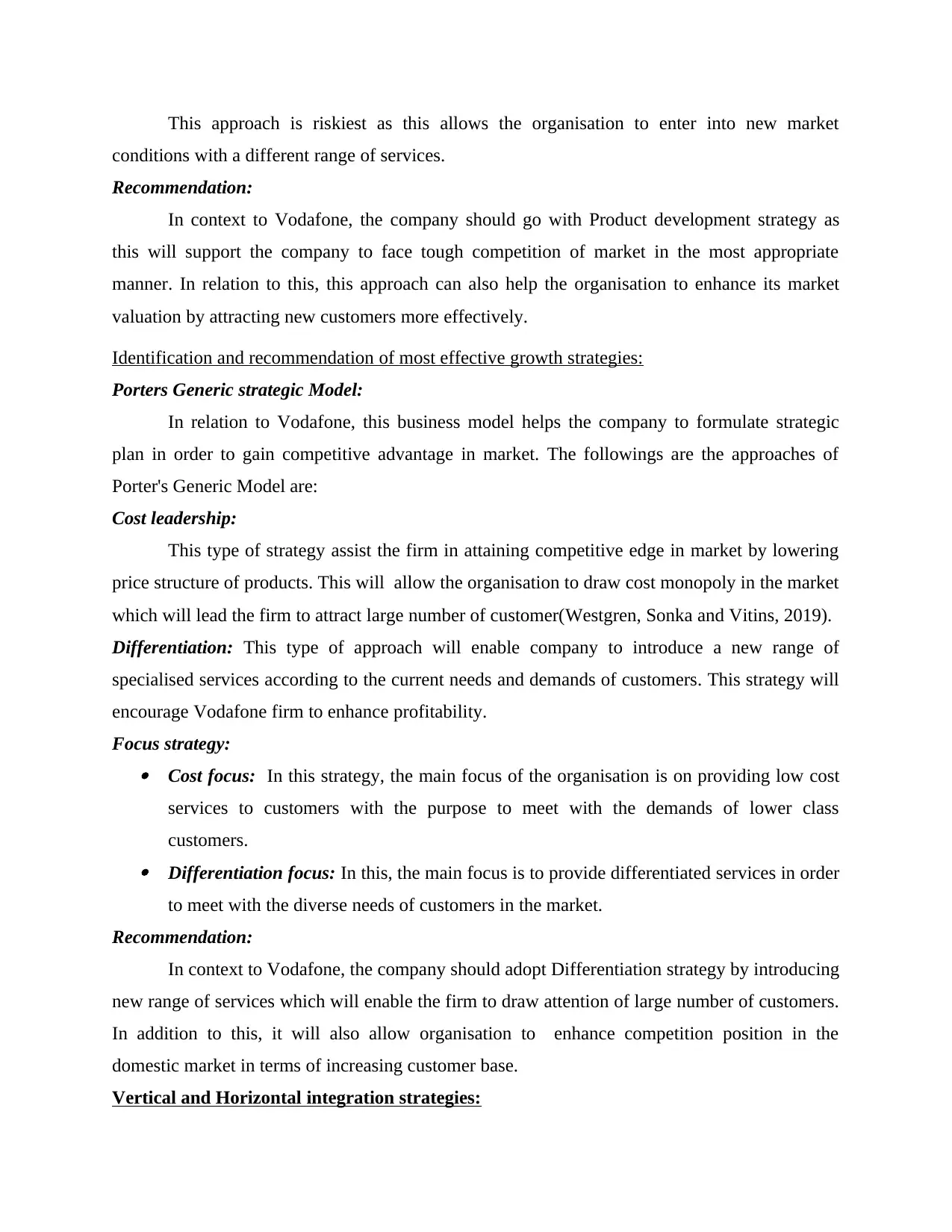
This approach is riskiest as this allows the organisation to enter into new market
conditions with a different range of services.
Recommendation:
In context to Vodafone, the company should go with Product development strategy as
this will support the company to face tough competition of market in the most appropriate
manner. In relation to this, this approach can also help the organisation to enhance its market
valuation by attracting new customers more effectively.
Identification and recommendation of most effective growth strategies:
Porters Generic strategic Model:
In relation to Vodafone, this business model helps the company to formulate strategic
plan in order to gain competitive advantage in market. The followings are the approaches of
Porter's Generic Model are:
Cost leadership:
This type of strategy assist the firm in attaining competitive edge in market by lowering
price structure of products. This will allow the organisation to draw cost monopoly in the market
which will lead the firm to attract large number of customer(Westgren, Sonka and Vitins, 2019).
Differentiation: This type of approach will enable company to introduce a new range of
specialised services according to the current needs and demands of customers. This strategy will
encourage Vodafone firm to enhance profitability.
Focus strategy: Cost focus: In this strategy, the main focus of the organisation is on providing low cost
services to customers with the purpose to meet with the demands of lower class
customers. Differentiation focus: In this, the main focus is to provide differentiated services in order
to meet with the diverse needs of customers in the market.
Recommendation:
In context to Vodafone, the company should adopt Differentiation strategy by introducing
new range of services which will enable the firm to draw attention of large number of customers.
In addition to this, it will also allow organisation to enhance competition position in the
domestic market in terms of increasing customer base.
Vertical and Horizontal integration strategies:
conditions with a different range of services.
Recommendation:
In context to Vodafone, the company should go with Product development strategy as
this will support the company to face tough competition of market in the most appropriate
manner. In relation to this, this approach can also help the organisation to enhance its market
valuation by attracting new customers more effectively.
Identification and recommendation of most effective growth strategies:
Porters Generic strategic Model:
In relation to Vodafone, this business model helps the company to formulate strategic
plan in order to gain competitive advantage in market. The followings are the approaches of
Porter's Generic Model are:
Cost leadership:
This type of strategy assist the firm in attaining competitive edge in market by lowering
price structure of products. This will allow the organisation to draw cost monopoly in the market
which will lead the firm to attract large number of customer(Westgren, Sonka and Vitins, 2019).
Differentiation: This type of approach will enable company to introduce a new range of
specialised services according to the current needs and demands of customers. This strategy will
encourage Vodafone firm to enhance profitability.
Focus strategy: Cost focus: In this strategy, the main focus of the organisation is on providing low cost
services to customers with the purpose to meet with the demands of lower class
customers. Differentiation focus: In this, the main focus is to provide differentiated services in order
to meet with the diverse needs of customers in the market.
Recommendation:
In context to Vodafone, the company should adopt Differentiation strategy by introducing
new range of services which will enable the firm to draw attention of large number of customers.
In addition to this, it will also allow organisation to enhance competition position in the
domestic market in terms of increasing customer base.
Vertical and Horizontal integration strategies:
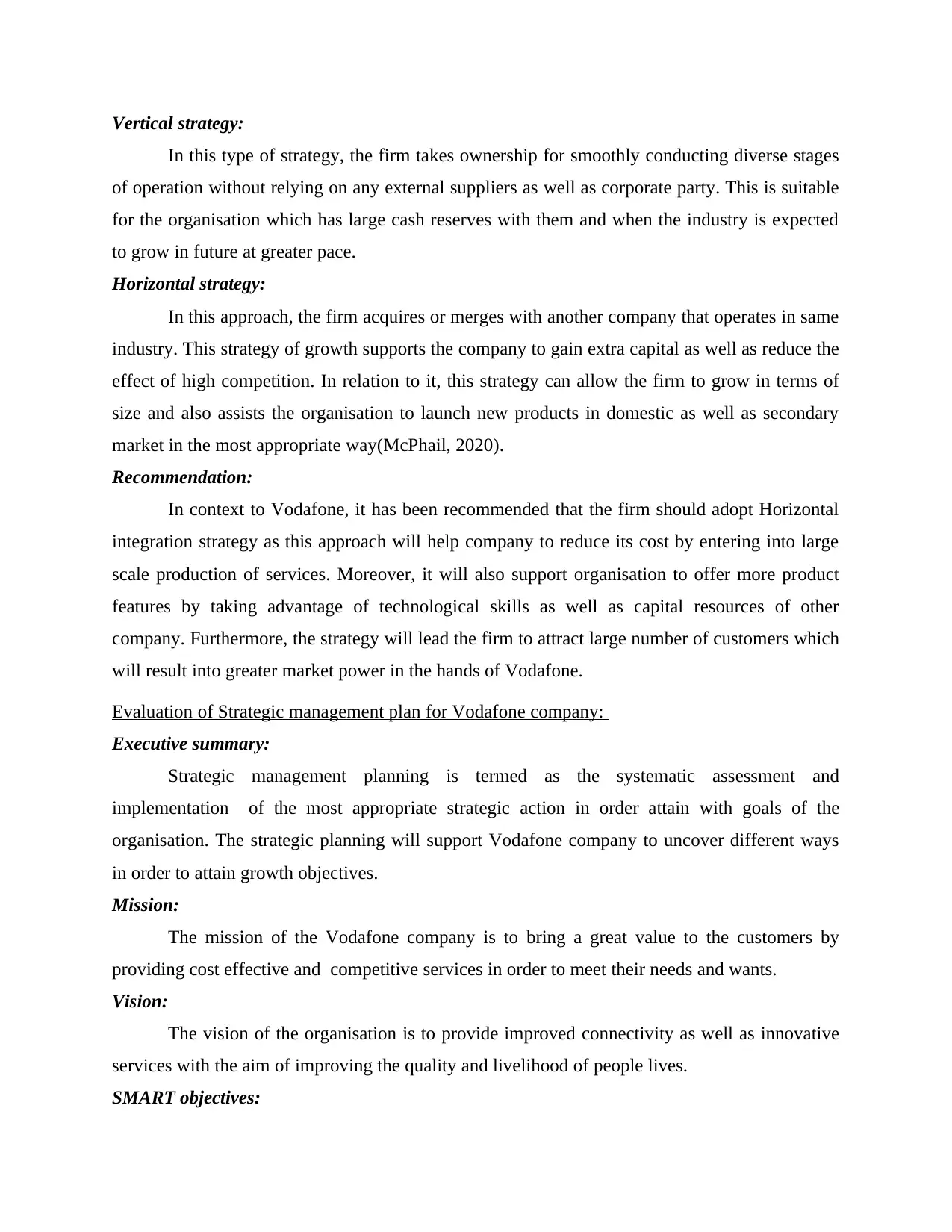
Vertical strategy:
In this type of strategy, the firm takes ownership for smoothly conducting diverse stages
of operation without relying on any external suppliers as well as corporate party. This is suitable
for the organisation which has large cash reserves with them and when the industry is expected
to grow in future at greater pace.
Horizontal strategy:
In this approach, the firm acquires or merges with another company that operates in same
industry. This strategy of growth supports the company to gain extra capital as well as reduce the
effect of high competition. In relation to it, this strategy can allow the firm to grow in terms of
size and also assists the organisation to launch new products in domestic as well as secondary
market in the most appropriate way(McPhail, 2020).
Recommendation:
In context to Vodafone, it has been recommended that the firm should adopt Horizontal
integration strategy as this approach will help company to reduce its cost by entering into large
scale production of services. Moreover, it will also support organisation to offer more product
features by taking advantage of technological skills as well as capital resources of other
company. Furthermore, the strategy will lead the firm to attract large number of customers which
will result into greater market power in the hands of Vodafone.
Evaluation of Strategic management plan for Vodafone company:
Executive summary:
Strategic management planning is termed as the systematic assessment and
implementation of the most appropriate strategic action in order attain with goals of the
organisation. The strategic planning will support Vodafone company to uncover different ways
in order to attain growth objectives.
Mission:
The mission of the Vodafone company is to bring a great value to the customers by
providing cost effective and competitive services in order to meet their needs and wants.
Vision:
The vision of the organisation is to provide improved connectivity as well as innovative
services with the aim of improving the quality and livelihood of people lives.
SMART objectives:
In this type of strategy, the firm takes ownership for smoothly conducting diverse stages
of operation without relying on any external suppliers as well as corporate party. This is suitable
for the organisation which has large cash reserves with them and when the industry is expected
to grow in future at greater pace.
Horizontal strategy:
In this approach, the firm acquires or merges with another company that operates in same
industry. This strategy of growth supports the company to gain extra capital as well as reduce the
effect of high competition. In relation to it, this strategy can allow the firm to grow in terms of
size and also assists the organisation to launch new products in domestic as well as secondary
market in the most appropriate way(McPhail, 2020).
Recommendation:
In context to Vodafone, it has been recommended that the firm should adopt Horizontal
integration strategy as this approach will help company to reduce its cost by entering into large
scale production of services. Moreover, it will also support organisation to offer more product
features by taking advantage of technological skills as well as capital resources of other
company. Furthermore, the strategy will lead the firm to attract large number of customers which
will result into greater market power in the hands of Vodafone.
Evaluation of Strategic management plan for Vodafone company:
Executive summary:
Strategic management planning is termed as the systematic assessment and
implementation of the most appropriate strategic action in order attain with goals of the
organisation. The strategic planning will support Vodafone company to uncover different ways
in order to attain growth objectives.
Mission:
The mission of the Vodafone company is to bring a great value to the customers by
providing cost effective and competitive services in order to meet their needs and wants.
Vision:
The vision of the organisation is to provide improved connectivity as well as innovative
services with the aim of improving the quality and livelihood of people lives.
SMART objectives:
Secure Best Marks with AI Grader
Need help grading? Try our AI Grader for instant feedback on your assignments.
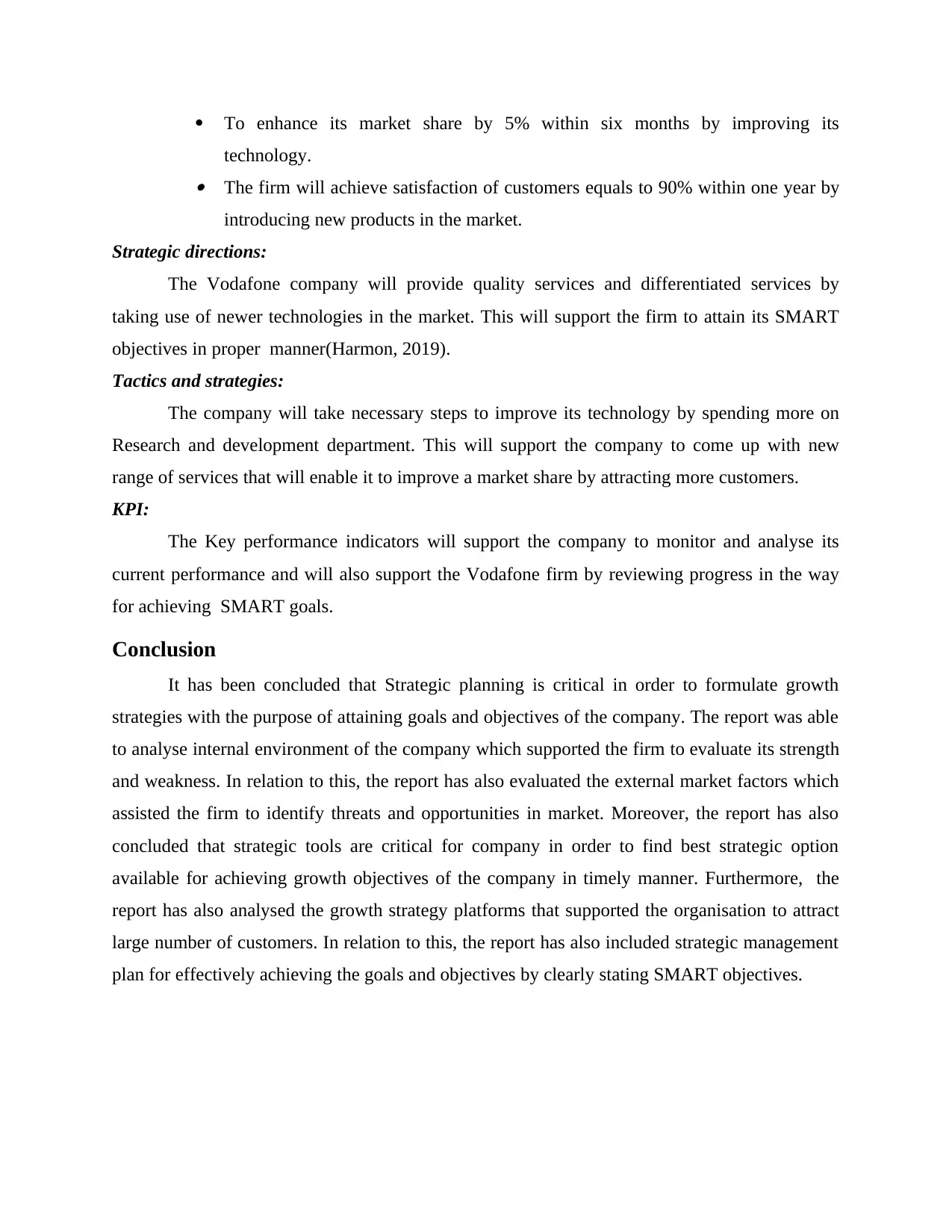
To enhance its market share by 5% within six months by improving its
technology.
The firm will achieve satisfaction of customers equals to 90% within one year by
introducing new products in the market.
Strategic directions:
The Vodafone company will provide quality services and differentiated services by
taking use of newer technologies in the market. This will support the firm to attain its SMART
objectives in proper manner(Harmon, 2019).
Tactics and strategies:
The company will take necessary steps to improve its technology by spending more on
Research and development department. This will support the company to come up with new
range of services that will enable it to improve a market share by attracting more customers.
KPI:
The Key performance indicators will support the company to monitor and analyse its
current performance and will also support the Vodafone firm by reviewing progress in the way
for achieving SMART goals.
Conclusion
It has been concluded that Strategic planning is critical in order to formulate growth
strategies with the purpose of attaining goals and objectives of the company. The report was able
to analyse internal environment of the company which supported the firm to evaluate its strength
and weakness. In relation to this, the report has also evaluated the external market factors which
assisted the firm to identify threats and opportunities in market. Moreover, the report has also
concluded that strategic tools are critical for company in order to find best strategic option
available for achieving growth objectives of the company in timely manner. Furthermore, the
report has also analysed the growth strategy platforms that supported the organisation to attract
large number of customers. In relation to this, the report has also included strategic management
plan for effectively achieving the goals and objectives by clearly stating SMART objectives.
technology.
The firm will achieve satisfaction of customers equals to 90% within one year by
introducing new products in the market.
Strategic directions:
The Vodafone company will provide quality services and differentiated services by
taking use of newer technologies in the market. This will support the firm to attain its SMART
objectives in proper manner(Harmon, 2019).
Tactics and strategies:
The company will take necessary steps to improve its technology by spending more on
Research and development department. This will support the company to come up with new
range of services that will enable it to improve a market share by attracting more customers.
KPI:
The Key performance indicators will support the company to monitor and analyse its
current performance and will also support the Vodafone firm by reviewing progress in the way
for achieving SMART goals.
Conclusion
It has been concluded that Strategic planning is critical in order to formulate growth
strategies with the purpose of attaining goals and objectives of the company. The report was able
to analyse internal environment of the company which supported the firm to evaluate its strength
and weakness. In relation to this, the report has also evaluated the external market factors which
assisted the firm to identify threats and opportunities in market. Moreover, the report has also
concluded that strategic tools are critical for company in order to find best strategic option
available for achieving growth objectives of the company in timely manner. Furthermore, the
report has also analysed the growth strategy platforms that supported the organisation to attract
large number of customers. In relation to this, the report has also included strategic management
plan for effectively achieving the goals and objectives by clearly stating SMART objectives.
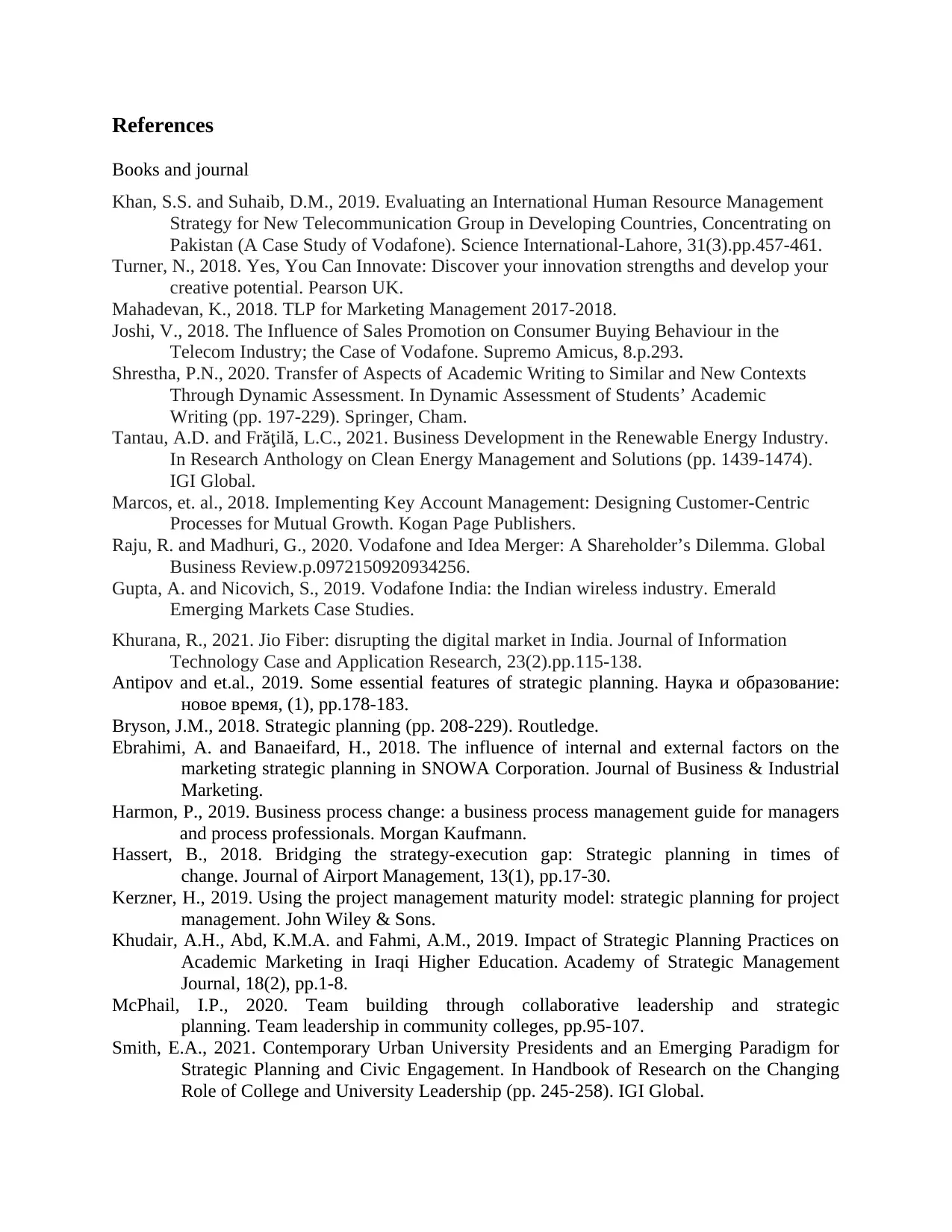
References
Books and journal
Khan, S.S. and Suhaib, D.M., 2019. Evaluating an International Human Resource Management
Strategy for New Telecommunication Group in Developing Countries, Concentrating on
Pakistan (A Case Study of Vodafone). Science International-Lahore, 31(3).pp.457-461.
Turner, N., 2018. Yes, You Can Innovate: Discover your innovation strengths and develop your
creative potential. Pearson UK.
Mahadevan, K., 2018. TLP for Marketing Management 2017-2018.
Joshi, V., 2018. The Influence of Sales Promotion on Consumer Buying Behaviour in the
Telecom Industry; the Case of Vodafone. Supremo Amicus, 8.p.293.
Shrestha, P.N., 2020. Transfer of Aspects of Academic Writing to Similar and New Contexts
Through Dynamic Assessment. In Dynamic Assessment of Students’ Academic
Writing (pp. 197-229). Springer, Cham.
Tantau, A.D. and Frăţilă, L.C., 2021. Business Development in the Renewable Energy Industry.
In Research Anthology on Clean Energy Management and Solutions (pp. 1439-1474).
IGI Global.
Marcos, et. al., 2018. Implementing Key Account Management: Designing Customer-Centric
Processes for Mutual Growth. Kogan Page Publishers.
Raju, R. and Madhuri, G., 2020. Vodafone and Idea Merger: A Shareholder’s Dilemma. Global
Business Review.p.0972150920934256.
Gupta, A. and Nicovich, S., 2019. Vodafone India: the Indian wireless industry. Emerald
Emerging Markets Case Studies.
Khurana, R., 2021. Jio Fiber: disrupting the digital market in India. Journal of Information
Technology Case and Application Research, 23(2).pp.115-138.
Antipov and et.al., 2019. Some essential features of strategic planning. Наука и образование:
новое время, (1), pp.178-183.
Bryson, J.M., 2018. Strategic planning (pp. 208-229). Routledge.
Ebrahimi, A. and Banaeifard, H., 2018. The influence of internal and external factors on the
marketing strategic planning in SNOWA Corporation. Journal of Business & Industrial
Marketing.
Harmon, P., 2019. Business process change: a business process management guide for managers
and process professionals. Morgan Kaufmann.
Hassert, B., 2018. Bridging the strategy-execution gap: Strategic planning in times of
change. Journal of Airport Management, 13(1), pp.17-30.
Kerzner, H., 2019. Using the project management maturity model: strategic planning for project
management. John Wiley & Sons.
Khudair, A.H., Abd, K.M.A. and Fahmi, A.M., 2019. Impact of Strategic Planning Practices on
Academic Marketing in Iraqi Higher Education. Academy of Strategic Management
Journal, 18(2), pp.1-8.
McPhail, I.P., 2020. Team building through collaborative leadership and strategic
planning. Team leadership in community colleges, pp.95-107.
Smith, E.A., 2021. Contemporary Urban University Presidents and an Emerging Paradigm for
Strategic Planning and Civic Engagement. In Handbook of Research on the Changing
Role of College and University Leadership (pp. 245-258). IGI Global.
Books and journal
Khan, S.S. and Suhaib, D.M., 2019. Evaluating an International Human Resource Management
Strategy for New Telecommunication Group in Developing Countries, Concentrating on
Pakistan (A Case Study of Vodafone). Science International-Lahore, 31(3).pp.457-461.
Turner, N., 2018. Yes, You Can Innovate: Discover your innovation strengths and develop your
creative potential. Pearson UK.
Mahadevan, K., 2018. TLP for Marketing Management 2017-2018.
Joshi, V., 2018. The Influence of Sales Promotion on Consumer Buying Behaviour in the
Telecom Industry; the Case of Vodafone. Supremo Amicus, 8.p.293.
Shrestha, P.N., 2020. Transfer of Aspects of Academic Writing to Similar and New Contexts
Through Dynamic Assessment. In Dynamic Assessment of Students’ Academic
Writing (pp. 197-229). Springer, Cham.
Tantau, A.D. and Frăţilă, L.C., 2021. Business Development in the Renewable Energy Industry.
In Research Anthology on Clean Energy Management and Solutions (pp. 1439-1474).
IGI Global.
Marcos, et. al., 2018. Implementing Key Account Management: Designing Customer-Centric
Processes for Mutual Growth. Kogan Page Publishers.
Raju, R. and Madhuri, G., 2020. Vodafone and Idea Merger: A Shareholder’s Dilemma. Global
Business Review.p.0972150920934256.
Gupta, A. and Nicovich, S., 2019. Vodafone India: the Indian wireless industry. Emerald
Emerging Markets Case Studies.
Khurana, R., 2021. Jio Fiber: disrupting the digital market in India. Journal of Information
Technology Case and Application Research, 23(2).pp.115-138.
Antipov and et.al., 2019. Some essential features of strategic planning. Наука и образование:
новое время, (1), pp.178-183.
Bryson, J.M., 2018. Strategic planning (pp. 208-229). Routledge.
Ebrahimi, A. and Banaeifard, H., 2018. The influence of internal and external factors on the
marketing strategic planning in SNOWA Corporation. Journal of Business & Industrial
Marketing.
Harmon, P., 2019. Business process change: a business process management guide for managers
and process professionals. Morgan Kaufmann.
Hassert, B., 2018. Bridging the strategy-execution gap: Strategic planning in times of
change. Journal of Airport Management, 13(1), pp.17-30.
Kerzner, H., 2019. Using the project management maturity model: strategic planning for project
management. John Wiley & Sons.
Khudair, A.H., Abd, K.M.A. and Fahmi, A.M., 2019. Impact of Strategic Planning Practices on
Academic Marketing in Iraqi Higher Education. Academy of Strategic Management
Journal, 18(2), pp.1-8.
McPhail, I.P., 2020. Team building through collaborative leadership and strategic
planning. Team leadership in community colleges, pp.95-107.
Smith, E.A., 2021. Contemporary Urban University Presidents and an Emerging Paradigm for
Strategic Planning and Civic Engagement. In Handbook of Research on the Changing
Role of College and University Leadership (pp. 245-258). IGI Global.
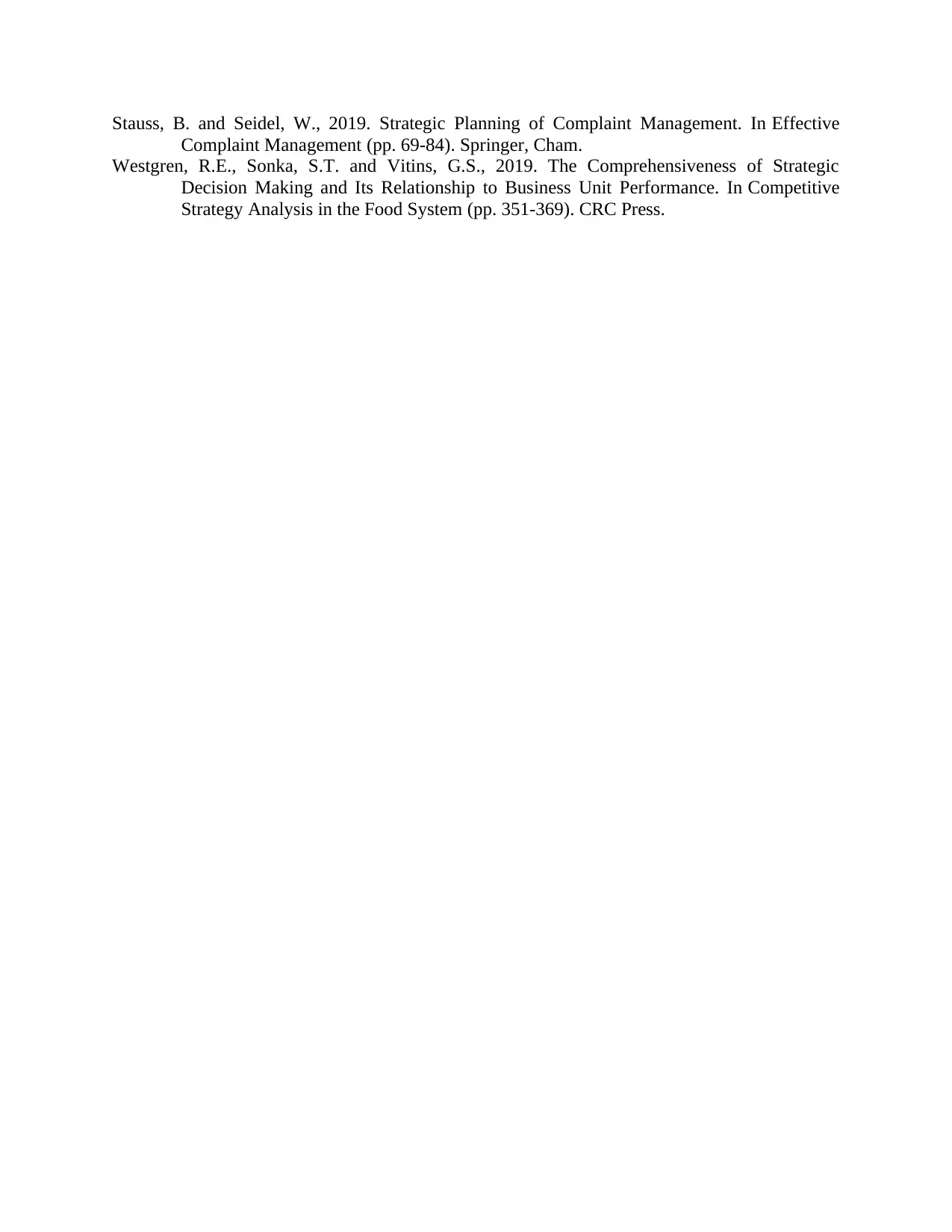
Stauss, B. and Seidel, W., 2019. Strategic Planning of Complaint Management. In Effective
Complaint Management (pp. 69-84). Springer, Cham.
Westgren, R.E., Sonka, S.T. and Vitins, G.S., 2019. The Comprehensiveness of Strategic
Decision Making and Its Relationship to Business Unit Performance. In Competitive
Strategy Analysis in the Food System (pp. 351-369). CRC Press.
Complaint Management (pp. 69-84). Springer, Cham.
Westgren, R.E., Sonka, S.T. and Vitins, G.S., 2019. The Comprehensiveness of Strategic
Decision Making and Its Relationship to Business Unit Performance. In Competitive
Strategy Analysis in the Food System (pp. 351-369). CRC Press.
Paraphrase This Document
Need a fresh take? Get an instant paraphrase of this document with our AI Paraphraser

1 out of 17
Related Documents
Your All-in-One AI-Powered Toolkit for Academic Success.
+13062052269
info@desklib.com
Available 24*7 on WhatsApp / Email
![[object Object]](/_next/static/media/star-bottom.7253800d.svg)
Unlock your academic potential
© 2024 | Zucol Services PVT LTD | All rights reserved.



